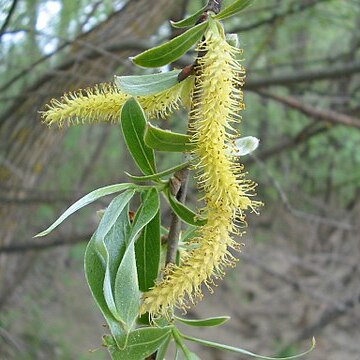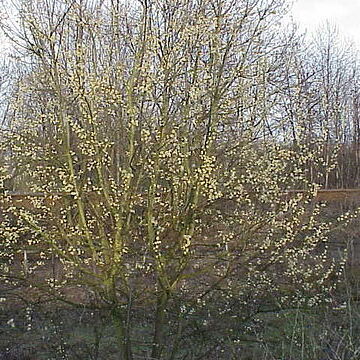Shrubs or trees, heterophyllous or not, sometimes clonal, forming clones by root shoots, rhizomes, layering, or stem fragmentation; glabrous or glabrescent to pubescent; branching monopodial or sympodial. Stems erect to pendent; branched. Leaves persistent, deciduous or marcescent, alternate (opposite or subopposite in Salix purpurea), spirally arranged, simple; stipules present or not; petiole present; blade margins toothed or entire, sometimes glandular. Peduncles present or absent. Inflorescences racemose or spicate, usually catkins, unbranched, sometimes fasciculate or racemelike cymes, flowering before or as leaves emerge or year-round; floral bract (1) subtending each flower, displaced onto pedicel or distinct, scalelike, apex entire, toothed, or laciniate; bract subtending pistillate flower deciduous or persistent. Pedicels present or absent. Flowers usually unisexual, sometimes bisexual, usually staminate and pistillate on different plants; sepals present or absent, or perianth modified into 1 or 2 nectaries, or a non-nectariferous disc; stamens 1-60(-70); filaments distinct or connate basally, slender; anthers longitudinally dehiscent; ovary 1, 2-7[-10]-carpellate, 1-7[-10]-locular; placentation usually parietal, sometimes axile on intruded, fused placentae; ovules 1-25 per ovary; style 1 per carpel, distinct or connate; stigmas 2-4, truncate, notched-capitate, or 2-or 3-lobed. Fruits capsular, baccate, or drupaceous. Seeds sometimes surrounded by arillate coma of relatively long, silky hairs; endosperm scant or absent.
Trees or shrubs, deciduous or rarely evergreen, dioecious, rarely polygamous. Leaves alternate, rarely subopposite, usually petiolate, simple; stipules persistent or caducous. Catkins erect or pendulous; each flower usually with a cupular disc or 1 or 2(or 3) nectariferous glands. Male flowers with 2-many stamens; filaments filiform, free or united; to connate; anthers 2(or 4)-loculed, dehiscing longitudinally. Female flowers with 1 pistil, sessile or stipitate; ovary superior, 1-or 2-loculed; ovules several to many, anatropous, with a 1 integument; style 1, 2 in Chosenia; stigmas 2-4. Capsule dehiscing by 2-4(or 5) valves; placenta and inside wall of ovary with long hairs. Seeds 4-numerous, glabrous; hairs and seeds simultaneously deciduous when capsule matures.
Dioecious trees or shrubs. Leaves alternate; stipules small or foliaceous, usually deciduous. Flowers grouped into unisexual catkins, often appearing before leaves; each flower subtended by a bract; perianth absent; disc present, often forming one or more fleshy glands. Male flower with 2–many stamens; filaments filiform, free or united; anthers 2-thecous, dehiscing longitudinally. Female flower with 1-locular ovary, 2–4 parietal placentas and numerous ovules; style 2–4-fid. Fruit a capsule, dehiscing longitudinally into 2–4 valves. Seeds numerous, very small, with large tuft of long hairs arising from funicle; embryo straight; endosperm absent
Flowers grouped into unisexual catkins, often appearing before the leaves; each flower subtended by a bract; perianth absent; disk present, often forming one or more fleshy glands
Flowers unisexual, dioecious, densely arranged in erect or pendulous catkins often appearing before the leaves; bracts membranous, each subtending a flower
Seeds small, with numerous fine hairs arising from the funicle and enveloping the seed; endosperm none; embryo straight
Seeds numerous, very small, with a large tuft of long hairs arising from the funicle; embryo straight; endosperm absent
Male flower with 2-many stamens, filaments filiform, free or united, anthers 2-thecous, dehiscing longitudinally
Female flowers: ovary sessile or shortly stipitate, 1-celled, with 2–4 parietal placentas; style 2–4-fid
Female flower: ovary 1-locular with 2–4 parietal placentas, ovules numerous, style 2–4-fid
Male flowers: stamens 2 or more, free or united; anthers 2-celled, opening lengthwise
Leaves alternate, deciduous; stipules small or foliaceous, usually deciduous
Calyx absent or represented by a cupular disk or 2 glandular scales
Leaves alternate, simple, deciduous; stipules small or foliaceous
Fruit a capsule, dehiscing longitudinally into 2–4 valves
Fruit a 2–4-valved capsule
Ovules numerous, ascending
Dioecious trees or shrubs
Trees or shrubs


